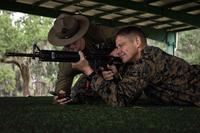Back in the day, Chief of Naval Operations Adm. Vern Clark used to tell anyone who would listen that he needed littoral combat ships "yesterday." Some top Navy officials continued to say that after he left, given the toll they said a high operational tempo was taking on the force. But even before the Navy got its next batches of LCS under contract, all that urgency seemed to evaporate. Today, the fleet's two existing ships, the steel and aluminum monohull USS Freedom and the aluminum trimaran USS Independence, are laid up for repairs. They won't do actual deployments for years, in part because LCS doctrine is based on multi-ship task groups and in part because the interchangeable mission equipment they need still isn't ready yet. The Navy may get where it wants to go with this program, but it's definitely no longer in a hurry.
For example, Naval Sea Systems Command announced this week that engineers are testing a key piece of LCS kit: A robot boat that tows a sensor through the water to hunt for sea mines. The Navy is banking on LCS to take over its minesweeping mission using this and other new toys, eventually assuming the place of its dedicated Avenger-class minesweepers. Planners also want LCS to swap in equipment that'll let it hunt submarines or fight surface battles. (Never mind that the Navy first "delivered" all three of these mission modules, including the mine countermeasures equipment, in 2007. That's in the past.) In the here and now, NavSea has demonstrated that, yep, its mine-hunting boat can do basic boat jobs:
The test, known as Phase 1 Sweep Operational Checkout, consisted of confirming that the new sweep system can be deployed and retrieved from a surface craft and that it tows properly. The test was the first use of the prototype Sweep Power Subsystem which includes magnetic and acoustic sweep systems. The first phase of testing was completed on July 1. Phase II is currently ongoing.
Eventually, the Navy says, this system will have to prove that it can actually find mines:
This summer's test program includes a full signature test and full mission profile where the entire UISS system will be tested in a series of integrated systems tests planned to demonstrate minesweeping capability in preparation for littoral combat ship mission package integration.
Then, assuming it works as advertised, the crew of an LCS eventually will get its hands on it and need to determine whether the ship can use its onboard equipment to launch and recover this thing. Then, sailors will need to determine if they can talk to the mine-hunting boat, and whether it can talk to them, to prove it would be useable in a real-world scenario. Then, at some point, the Navy will need to decide whether to buy enough of them to equip its planned fleet of 55 littoral combat ships. Then, at some point after that, the Navy may be able to field enough ships and enough modules that LCS can accept missions somewhere in the world.
You might be puzzled by this laid-back approach to fielding what the Navy has promised will be an amazing new capability for combatant commanders. After all, top Navy officials just told Congress that today's fleet is disintegrating under the incessant demand for ships, submarines and aircraft. We're going as fast as we can, the admirals would probably say. These things take time. Fine, but by their own account, the existing ships in the surface force are quickly wearing out -- if it continues at this rate, can LCS become operational in time to make a difference?







